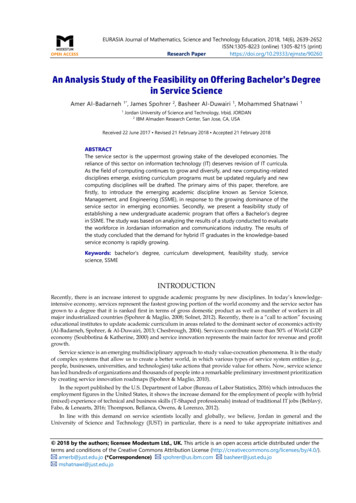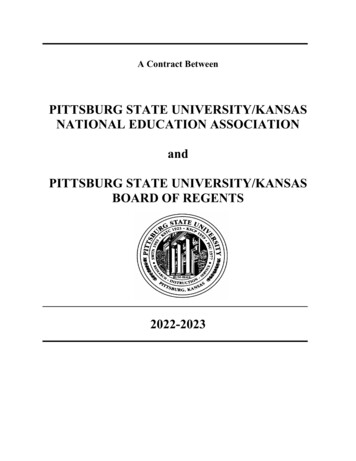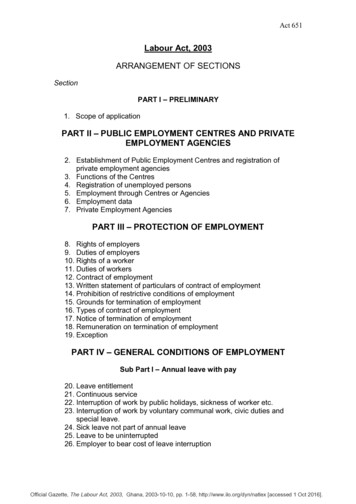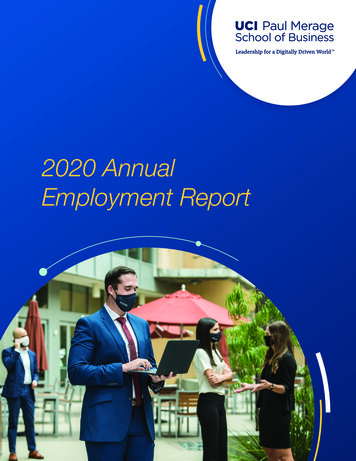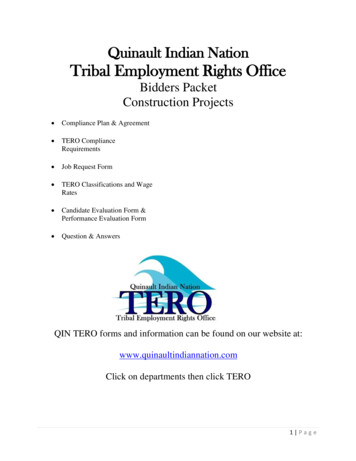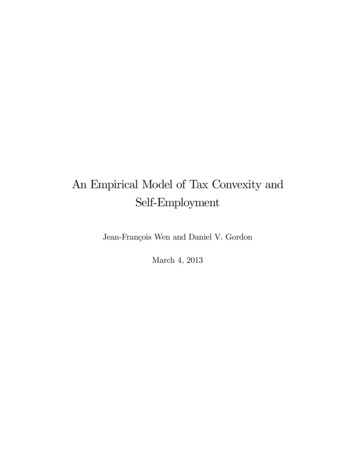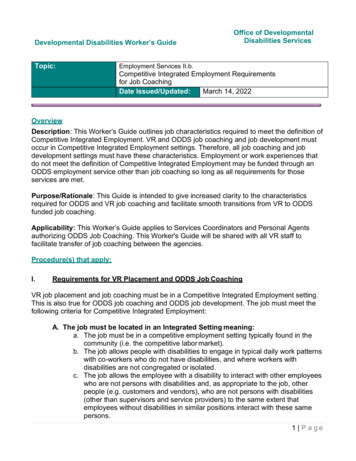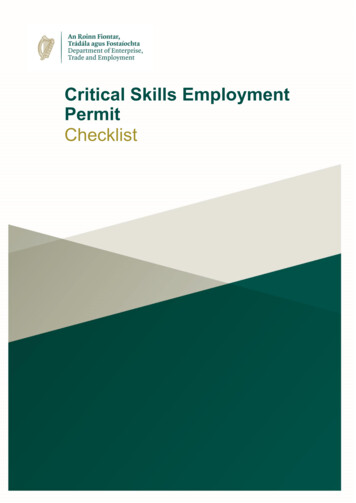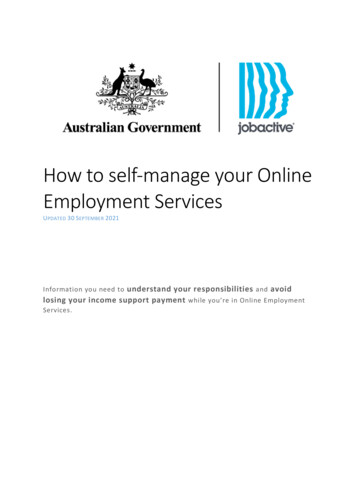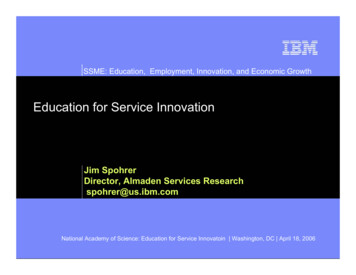
Transcription
SSME: Education, Employment, Innovation, and Economic GrowthEducation for Service InnovationJim SpohrerDirector, Almaden Services Researchspohrer@us.ibm.comNational Academy of Science: Education for Service Innovatoin Washington, DC April 18, 2006
SSME: Education, Employment, Innovation, and Economic GrowthIBM Perspective on Services: Business & ITBusiness Consulting Services &Project-based gStrategicOutsourcing& IT Hardware,Software &Services2003: 50 of 3000 of 320,0002006: 550 of 3200 of 340,0002IBM ResearchApplicationManagement 2006 IBM Corporation
SSME: Education, Employment, Innovation, and Economic GrowthGlobal Services: Opportunities & Challenges OpportunitiesGlobalization (Developed & Developing)ICT (R)evolution (eServices & Semantics)Business Performance Transformation Services (BPTS)Service Entrepreneurship (SME) ChallengesEducation (Talent & Tools: High Value Jobs)Innovation (Investment & Protection: High Value Exports)Science (Formalization of Service Systems & SystematicMethods: Sustainable Growth)3IBM Research 2006 IBM Corporation
SSME: Education, Employment, Innovation, and Economic GrowthWhat will the next new service industry be? Online game worlds forbusiness applications? Google Search (lessthan a decade old) Semantic Search? Book: Blue OceanStrategies4IBM Research 2006 IBM Corporation
SSME: Education, Employment, Innovation, and Economic Growth“We are continuallycreating a newand novel world.”- Douglass C. North“Innovative activityis fundamentally aservice activity.”- William J. BaumolAnd the rate of change isproportional to the sizeof the service sector-Jim SpohrerServiceEconomyNew Industries New SpecialistsKnowledge WorkersEducation & Employment5IBM ResearchBased on slides by Jean Paul Jacob, IBM Researcher Emeritus 2006 IBM Corporation
SSME: Education, Employment, Innovation, and Economic GrowthEndless Stream of Industries & Knowledge Workers Government& securityHealth &educationFinancial &insuranceProfessional& businessInformation &communicationRetail &wholesaleLeisure &hospitalityTransportation& utilitiesHigh rproducer,director,proprietor,designer,star athleteperformerpilot, tant,HR, PR,marketing,business devtechnician,systemadministrator,journalist, writer,announcerbuyer, highend zedlabor intensivepolice,firefighter,securityguardnurses aid,day igatorsadmin.assistant,hiringspecialist,door to doorsalescall centerspecialist,librariansales clerk,stocker,shipping truck driver,field nspectors,data entrydata entrybank neoperatorsalescounterclerksfast uestsubscriber,commuter- based on Herzeberg et al, (1998). All occupations span a range, placement is representative only.6IBM Research 2006 IBM Corporation
SSME: Education, Employment, Innovation, and Economic GrowthService jobs are increasingly the high skill knowledge workerjobs – especially in business and information services95% of all business executives and research scientists are alive today.Type of izedLaborIntensive25%25%26%15%Maid, childcareTightlyConstrained6%5%4%10%Call center,Fast foodFrom Herzenberg, Alic, Wial (1998)7Example1996IBM Research-from Herzenberg, Alic, & Wial (1998). New rules for a new economy.Employment and opportunity in postindustrial America.Cornell University Press. 2006 IBM Corporation
SSME: Education, Employment, Innovation, and Economic GrowthFour worlds of services jobs, up stream and down stream for enablePeopledevelopConsumer servicesNon-market servicesdesignProductsoperate &maintainIndustrial services8IBM ResearchenableBusinesstransformBusiness servicescreateInformationutilizeInformation services 2006 IBM Corporation
SSME: Education, Employment, Innovation, and Economic GrowthU.S. Employment Percentages by Sector10090807060504030201001800Services (Info)Services (Other)Industry (Goods)Agriculture18501900195020002050Estimations based on Porat, M. (1977) Info Economy: Definitions and Measurement,Augmented with recent data and projections from http://www.bls.gov/9IBM Research 2006 IBM Corporation
SSME: Education, Employment, Innovation, and Economic GrowthProjected US Service Employment Growth, 2004 - 2014US Bureau of Labor /art03.pdf10IBM Research 2006 IBM Corporation
SSME: Education, Employment, Innovation, and Economic GrowthFour targets of knowledge intensive service activities people, business, products, and informationHas RightsSpatially localized& drive to increaselocal capabilities(Physical)Potentially distributed &drive to increasenetwork Is Owned11IBM ResearchProductsInformation(technology artifactsand environment)(capital, reputation,process, laws, science) 2006 IBM Corporation
SSME: Education, Employment, Innovation, and Economic GrowthDefinition of services (based on Gadrey, 2002)A. Service Provider- Individual- Organization- Technologyowned by AForms ofService Relationship(A & B coproduce value)B. Service Client- Individual- Organization- Public or PrivateForms ofForms ofForms ofService InterventionsResponsibility RelationshipOwnership Relationship(A on C, B on C)(A on C)(B on C)C. Service Target: The reality to betransformed or operated on by A,for the sake of B-People, dimensions of-Business, dimensions of-Products, technology artifacts & env.-Information, codified knowledge12IBM Research 2006 IBM Corporation
SSME: Education, Employment, Innovation, and Economic GrowthServices Systems: Value coproduction networks of people,technology, organizations, and shared information So two types of service innovation Integrate technology, business, social-organizational, demand innovations Type 1: Supply or Production-Side Innovation: New Plans: NewWays of Doing Things: Business Performance TransformationServices: Put existing service systems on improvement trajectoriesAugmentationReconfigurationInvention Type 2: Demand-Side Innovation: New Goals: New Needs, Wants,Aspirations: Entrepreneurship: Create new types of service systemsAugmentationReconfigurationInvention13IBM Research 2006 IBM Corporation
SSME: Education, Employment, Innovation, and Economic GrowthSo perhaps we need A new generalist profession, a service scientist(entrepreneur?) A new tool, the CAD/CAM for service systems A new academic transdiscipline to integrate across disciplinesilos, SSME Herzenberg et al: Economies of depth (specialists) andcoordination (generalists) Carley: Optimal ratio of generalists to specialists14IBM Research 2006 IBM Corporation
SSME: Education, Employment, Innovation, and Economic GrowthToday’s talk What is SSME or “a Science of Services”?Why is SSME so important?Why does IBM care?Who else cares?What kinds of skills should a service scientist have?- Is there a “Services Rosetta Stone?” 15What kinds of tools should a service scientist have?What does a service scientist actually do?Are there “scale laws” of service innovation?Questions?IBM Research 2006 IBM Corporation
SSME: Education, Employment, Innovation, and Economic GrowthWhat is SSME?(Services Sciences, Management, and Engineering) An urgent “call to action”To become more systematic about innovation in servicesComplements product and process innovation methodsTo develop “a science of services” A proposed academic disciplineDraws on many existing disciplinesAims to integrate them into a new specialty A proposed research areaService systems are designed (computer systems)Service systems evolve (linguistic and social systems)Service systems have scale-emergent properties (economic systems)16IBM Research 2006 IBM Corporation
SSME: Education, Employment, Innovation, and Economic GrowthWhat is SSME?(Services Sciences, Management, and Engineering) The application of scientific, management, and engineering disciplines to tasksthat one organization beneficially performs for and with another (‘services’)Understand the evolution and design of service systemsMake productivity, quality, compliance, sustainability, and innovation rates more predictableServices are anything of economic value that cannot be dropped on your footServices are value coproduction performances and promises between clients and providers Science is a way to create knowledge Engineering is a way to apply knowledge and create new value Management improves the process of creating and capturing value17IBM Research 2006 IBM Corporation
SSME: Education, Employment, Innovation, and Economic GrowthWhy is SSME so important? Governments need to make service innovation a priorityGDP growth of nations increasingly depends on it Businesses need to make service innovation a priorityRevenue and profit growth increasingly depend on it Academics need to make service innovation a priorityStudents’ futures depend on itImproved education productivity and quality depends on itNew frontier of research with business and societal impact18IBM Research 2006 IBM Corporation
SSME: Education, Employment, Innovation, and Economic GrowthWhy is SSME so important?Because the world is becoming a service system.Top Ten Nations by Labor Force Size(about 50% of world labor in just 10 nations)A Agriculture, G Goods, S ServicesNation% WW %Labor A%G%S25 yr %delta SChina21.050 1535191India17.060 172328U.S.4.83 277021Indonesia3.945 163935Brazil3.023 245320Russia2.512 236538Japan2.45 257040Nigeria2.270 102030Banglad.2.263 112630Germany1.43 33644420042004United States(A) Agriculture:Value fromharvesting nature(G) Goods:Value frommaking products(S) Services:Value from enhancing thecapabilities of things (customizing,distributing, etc.) and interactions between thingsThe largest labor force migrationin human history is underway,driven by global communications,business and technology growth,urbanization and low cost labor. 50% (S) services, 33% (S) services19IBM Research 2006 IBM Corporation
SSME: Education, Employment, Innovation, and Economic GrowthWhy does IBM care? Our ability to hire needed talent and innovateIBM played a role in establishing Computer ScienceNow IBM is working with academics andgovernment to establish Service ScienceEngineering and Natural SciencesEngineering and Natural SciencesSocial SciencesSocial SciencesBusiness and ManagementBusiness and ManagementLiberal Arts and HumanitiesLiberal Arts and HumanitiesOtherOtherPhD’s & Masters in U.S. IGS and IBM ResearchPhysicistsComputerScienceElectrical EngineersMathematiciansPhilosophers(Boolean Logic)Need to hire Computer Scientists20IBM ResearchNeed to hire Service Scientists 2006 IBM Corporation
SSME: Education, Employment, Innovation, and Economic GrowthWho else cares? GovernmentsUS, EU, European Commission, China, Japan, Germany, UK, Finland,Norway, Denmark, Sweden, Italy, Netherlands, Russia, India, Belgium,and othersUS Department of Commerce, NSF, NIST, DARPA, VTT,etc. IndustryIBM, Accenture, HP, EDS, CSC, Cisco, P&G, American Express, JohnDeere, Avaya, Oracle, and many others AcademicsASU, PSU, NCSU, Berkeley, RPI, UCSC, Georgia Tech, Bentley,Stanford, CMU, UCLA, BYU, Yale, Harvard, MIT, Northwestern,UArizona, UMaryland, UGeorgia, UMichigan, UTexas, MichiganSU,Columbia, Oxford, Warwick, Tokyo University, Peking University,Carlsruhe, AIO, Norwegian School of Economics, Helsinki Universityof Technology, University of Rome La Sapienza, and many others OthersBestServ, OECD, Institute for the Future, Bay Area Economic Forum, etc.21IBM Research 2006 IBM Corporation
SSME: Education, Employment, Innovation, and Economic GrowthEvolution &RevisionSchool ofManagementMarketingService MarketingOperationsService OperationsAccountingService Accounting(Activity-Based Costing)Contracts & NegotiationsService Sourcing(eSourcing)Management ScienceService ManagementManagement ofTechnologyManagement ofInnovationOperations ResearchService OperationsIndustrial & SystemsEngineeringService EngineeringComputer ScienceService Computing, WebServices, SOAEconomicsInstitutional EconomicsExperimental EconomicsPsychologyLabor Psychology(Human Capital Mgmt)AnthropologyBusiness AnthropologySchool of Engineeringand ScienceSchool of Social SciencesOrganization TheoryOther22Information Science & Systems, Service professionalschoolsIBM ResearchSelection &AggregationTransformation& IntegrationServices Sciences, Management, and Engineering(SSME) and Solutions EngineeringDisciplineService & Solutions Excellence Centers(Information Science & Technology Management)School 2006 IBM Corporation
SSME: Education, Employment, Innovation, and Economic GrowthWhat kinds of skills should a service scientist have? TechnologyMake, Verify, Deliver, Operate, plus eServices & eMarkets BusinessPropose (win-win), Finance, Market, Manage, plus eBusiness & eMarkets Social-OrganizationalCoordinate, Motivate, Govern, Learn, plus eSourcing and eMarketsEducation in reading, writing, and arithmetic (3 R’s) enabled 19th century innovation.Add science, technology, engineering, and mathematics (STEM) for the 20th century.Add more info. technology, business, and social-organizational enable 21st century, al (STEEP).23IBM Research 2006 IBM Corporation
SSME: Education, Employment, Innovation, and Economic GrowthWhat kinds of skills should a service scientist have?Academic disciplines evolving to combine technology, business, and social-organizationBefore 19001. Education1960-1990Technology2. Sociology17. ExperimentalEconomics3. Law4. Economics6. ManagerialPsychology7. Human CapitalManagement (HCM)8. Organization Theory9. Operations Research10. Systems Engineering11. Management Science12. Game Theory13. Industrial Engineering14. Marketing15. Computer &Information Sciences18. AI & Games155. BusinessAdministration (MBA)2416. Management ofInnovation & Tech (MoT)119. Management ofInformation Systems13 101824192621 2328922 1627 252078 21417 45116BusinessSocial12Organizational31900-1960IBM Research1990-200420. Computer SupportedCollab. Work (CSCW)21. PerformanceSupport Systems InBusiness & Organization22. Inform. Sci & Sys23. Service Ops & Mgmt24. Service Engineering25. Service Marketing26. Social Complexity27. Agent-basedcompute. economics28. ComputationalOrganization Theory 2006 IBM Corporation
SSME: Education, Employment, Innovation, and Economic GrowthWhat kinds of tools should a service scientist have? Empirical tools – simulation tools and techniques Analytic tools – mathematical tools and techniques Engineering tools – workbench to assemble standard components,and infrastructure platform to deploy them into practice Multidisciplinary design tools – palette of customizations Theoretical tools – standard terminology, measures, and principles25IBM Research 2006 IBM Corporation
SSME: Education, Employment, Innovation, and Economic GrowthWhat kinds of tools should a service scientist t structureKnowledgeBasedMarketDesignTraderACAME Web ServiceTransaction objectTraderBCAME Web ServiceCAME (WEB) SuiteMarketEngineeringWorkbench( Bichler, Kersten, Strecker 2003)(Transcoop, Weinhardt, Neumann,2003)For Example: Computer-Aided Market Engineering System(AvH and SSHRC)D. Neumann, J. Maekioe, C. Weinhardt (2005): CAME - A Toolset for Configuring Electronic Markets; In: Proceedings of the ECIS 2005, Regensburg26IBM Research 2006 IBM Corporation
SSME: Education, Employment, Innovation, and Economic GrowthWhat would service scientists actually do? Service scientist own the body of knowledge around service systemproblem solving Service scientists identify a service system that needs improvement Service scientists identify the stakeholders their concerns and perceivedopportunities Service scientists envision augmentations (additional new servicesystems) or reconfigurations (of old service systems components) thatbest address all problems and opportunitiesIdentify year-over-year improvement trajectoriesIdentify incentives to change (ROI, leadership, laws)27IBM Research 2006 IBM Corporation
SSME: Education, Employment, Innovation, and Economic GrowthExample: Are there “scale laws” of service innovation –year-over-year compounding effects? ProblemsYear 1:20%Year 2:20%Year 3:20%Input: Student qualityProcess: Faculty motivationOutput: Industry fit Augmentations.A: -20% eLearning certificationB. 10% Faculty interest tuningC. 10% On-the-job skills tuningYear N:.20%After a decade the course may look quite differentService systems are learning systems: productivity, quality, etc.28IBM Research 2006 IBM Corporation
SSME: Education, Employment, Innovation, and Economic GrowthA Grand Challenge: Predictable Service Productivity GrowthProductivity Other ConsiderationsGlobalValues, Demands,Aspirations, Wants, NeedsSustainability& DemandNationalPolicies & Laws,Public InfrastructuresGrowth &InnovationIndustryCrime, Terrorism,Cheating, Other MischiefStandards& ComplianceEnterpriseFoundations, Not-for-Profits,Research OrganizationsGrowth &InnovationWork SystemGraduates fromSchools & UniversitiesQuality& LearningKnowledge WorkerProfessionsFamily Life, LocalCommunity, EnvironmentOpportunity& SustainabilityIBM ResearchMeasurement of Service SystemsMeasurement of Sociotechnical Systems29Issues 2006 IBM Corporation
SSME: Education, Employment, Innovation, and Economic GrowthQuestions?Focus on Education, Employment, Innovation, Economic Growth:Complex Business Performance Transformation ServicesService Marketing, Operations, and ManagementOperations Research and Management ScienceIndustrial & Systems Engineering, Control TheoryInformation Sciences and Systems EngineeringManagement of Technology and InnovationComputer Science, Distributed AI, CSCWComputational Organization TheorySocial and Cognitive ScienceEconomics & JurisprudenceGame Theory and Mechanism Design TheoryManagement of Information SystemsOrganization Science, Complexity Management TheoryBusiness Informatics and Document EngineeringBusiness Anthropology and Learning OrganizationsDecision Science and Knowledge ManagementHuman Capital Management & Incentive EngineeringQuality, Six Sigma, Statistics, Process OptimizationComputer Aided Market EngineeringSSMEService ScienceServices: Value coproduction acts, promises, and relationshipsvia sharing work, risk, information, assets, decisions, responsibility, and authority30IBM Research 2006 IBM Corporation
SSME: Education, Employment, Innovation, and Economic GrowthREST IS BACKUPContactPaul Maglio ( maglio@us.ibm.com )Wendy Murphy ( wendym@us.ibm.com )National Academy of Science: Education for Service Innovatoin Washington, DC April 18, 2006
SSME: Education, Employment, Innovation, and Economic GrowthSo What? What is the key to being more innovative in services? What is the key to increasing high skill jobs that enable more serviceinnovation? What is the key to developing innovative, high value servicesexports? In short, what policies, investments, research, and education is mostneeded? Challenge: Services breeding like rabbits – is the future simply anunending stream of new specialists hopping from innovation tocommoditization, and back?32IBM Research 2006 IBM Corporation
SSME: Education, Employment, Innovation, and Economic GrowthInnovation sustains skilled employment and exports1800-EnglandIndustrial Revolution1850-GermanyChemicals Revolution1900-USAElectrical & Information Revolution1950-JapanQuality Innovation: Product Revolution1990-FinlandMobile Communication Revolution2000-IndiaCost Innovation: Services Revolution2000-ChinaCost Innovation: Product Revolution?Future of Products & Services ExportsSustainable growth depends on innovation viaregional government, industry, academic collaboration.33IBM Research 2006 IBM Corporation
SSME: Education, Employment, Innovation, and Economic GrowthHistorical Example: Emergence of new academic disciplineand systematic approach to innovation and wealth creation Emergence of German dye industry, German mid-19th Century Emergence of chemistry as an academic discipline Emergence of patent protection in the new area of chemicalprocesses and formula Emergence of new relationships connecting firms, academicinstitutions, government agencies, and clients Demonstrates needed coevolution of firms, technology, and nationalinstitutions Took England and US over 70 years to catch up!!!Knowledge and Competitive Advantage :The Coevolution of Firms, Technology, and National Institutionsby Johann Peter Murmann34IBM Research 2006 IBM Corporation
SSME: Education, Employment, Innovation, and Economic Growth“We are continuallycreating a newand novel world.”- Douglass C. North“Innovative activityis fundamentally aservice activity.”- William J. BaumolServiceEconomyKnowledge WorkersEducation & Employment35IBM Research 2006 IBM Corporation
SSME: Education, Employment, Innovation, and Economic GrowthAre there “scale laws” of service innovation? Moore’s Law underlies much of the information technology and business capability growth over thelast half centuryAre there analogous “predictable capability doubling laws” that apply in the realm of services? If so, how might theybe exploited to improve service productivity and quality in a predictable manner?It seems three improvement or learning curve laws that might be applicable in services:The more an activity is performed (time period doubling, demand doubling) the more opportunities there are toimprove the processThe better an activity can be measured (sensor deployment doubling, sensor precision doubling, relevantmeasurement variables doubling) and modeled the more opportunities there are to improve the processThe more activities that depend on a common sub-step or process (doubling potential demand points), the morelikely investment can be raised to improve the sub-step. Example: Amazon’s Book Buying Recommendation Service QualityThe quality of the recommendations depends on accurate statistics – the more purchases made, the better thestatistical estimates for recommendations Example: Call Centers Query-Response Productivity and QualityThe speed and quality of call center responses can be improved significantly given accurate statistics about thekinds and number of queries that are likely to be received. Example: New Service Offerings Viability (Blue Ocean Strategy)The viability of new service offerings often depends on the scale (amount of demand) in adjacent market segmentswhere service satisfaction is low enough to result in sufficient critical mass of defections to bootstrap the newoffering. Example: Predictable Education Gains (Student Knowledge, Teacher Satisfaction)If eLearning can be used to shift 20% of routine teacher activities into automation that can be covered in half thenormal time, freeing up 10% of teacher time each year to innovate and add new content or exploratory activitiesto the curriculum, then each year students will be learning more and teachers will have time to try new things.36IBM Research 2006 IBM Corporation
SSME: Education, Employment, Innovation, and Economic GrowthWhat is SSME?(Services Sciences, Management, and Engineering) The application of scientific, management, and engineering disciplines to tasksthat one organization beneficially performs for and with another (‘services’)Make productivity, quality, compliance, sustainability, learning rates, and innovation rates more predictablein the service sector, especially complex organization to organization services – business to business,nation to nation, organization to populationServices are anything of economic value that cannot be dropped on your foot – the key to service value is inactions, performed now or promised for the future. Services transform/protect or promise totransform/protect a state of the target of the service. The client may not have the skill, time, desire, orauthority to perform self-service, do it themselves. Services often create mutual interdependencies.Services are value coproduction performances and promises between clients and providers, with alternativework sharing, risk sharing, information sharing, asset sharing, and decision sharing arrangements andrelationships (promises to perform now or in the future, once or repeatedly, when needed or demanded,standard or customized, satisfaction guaranteed or best effort, service levels fixed or variable) Science is a way to create knowledgeEngineering is a way to apply knowledge and create new valueBusiness Model is a way to apply knowledge and capture valueManagement improves the process of creating and capturing value37IBM Research 2006 IBM Corporation
SSME: Education, Employment, Innovation, and Economic GrowthWhat can you do to get involved? [government] 38Does your agency fund innovation?Does your agency influence innovation policy?Does your agency establish standards?Does your agency deal with intellectual property?Does your agency deal with economic statistics?IBM Research 2006 IBM Corporation
SSME: Education, Employment, Innovation, and Economic GrowthWhat can you do to get involved? [industry] Does your business develop, sell, and/or deliver service offerings? Does your business have a service innovation process? Does your business use services to complement and add value tomanufactured products? Does your business invest in internal R&D? Does your business fund university or other external R&D? Does your business create case studies, success stories, white papers, orpoint-of-view documents about service offerings? Does your business recruit service professionals? Service researchers? Does your business provide feedback to schools (survey recent graduateshired) on what skills are desired to be most effective in your business? Does your business procure services? eSource of services? Outsourceservices? Does your company patent or otherwise protect intellectual property relatedto service innovation?39IBM Research 2006 IBM Corporation
SSME: Education, Employment, Innovation, and Economic GrowthWhat can you do to get involved? [academics] Do you teach courses that include or could include complex business tobusiness service case studies? Do you have responsibility for revising or creating new curriculum? Do you perform research that could be published in the Journal of ServiceResearch or other relevant journals or conferences? Do you have students who could intern with business service or serviceresearch organizations? Compete for PhD fellowships in services? Are you interested in industry-academic rotations? Are you interested in developing tools that could enable SSME? Are you interested in creating business proposals or grant proposalsrelated to SSME and service innovation? Competing for universityresearch awards? Are you interested in participating/speaking in SSME events? Hosting oneat your university? Does your school already have services related courses, degrees, centers,or institutes? Are you a service innovation pioneer? Are you interested in competing fora faculty award?40IBM Research 2006 IBM Corporation
SSME: Education, Employment, Innovation, and Economic GrowthWhat is IBM doing to support others? Publicizing a “call to action” around SSME and the need for systematicapproaches to service innovation (identify IBM relationship/ambassadors) Hosting and cosponsoring SSME and service innovation related events withgovernment, industry, and academics around the world IBM Faculty Awards to select service innovation pioneers IBM PhD Fellowships to select services-related PhD students IBM University Research (SUR) awards to select academic institutionsproposing leading edge service innovation and SSME related work Providing best paper awards for leading service research related journalsand conferences Working with government funding agencies to increase focus and establishnew programs related to service innovation Inviting people to contribute to an SSME blog, and share information abouttheir SSME related efforts (http://www.research.ibm.com/ssme) Working with some academic institutions to provide access to service data Hiring recent graduates into IBM Global Services and IBM Research Supporting curriculum development and research efforts, and much more 41IBM Research 2006 IBM Corporation
SSME: Education, Employment, Innovation, and Economic GrowthIBM’s SSME Course (Under Development)1. Services – What are services?2. Systems – Services depend on sociotechnical systems3. Methods – Service delivery depends on methods4. Industrialization – Services are being standardized5. Quality – How do we ensure quality of service?6. Components – Business processes are being modularized7. Science – Is there a science of services?8. Management – What is different in management of services?9. Engineering – Can service engineering foster innovation?10. Productivity – Why do services resist productivity gains?11. Challenges – What are the big problems for the service economy?12. Innovation – C
SSME: Education, Employment, Innovation, and Economic Growth IBM Research 2006 IBM Corporation Global Services: Opportunities & Challenges Opportunities Globalization (Developed & Developing) ICT (R)evolution (eServices & Semantics) Business Performance Transformation Services (BPTS) Service Entrepreneurship (SME) Challenges
